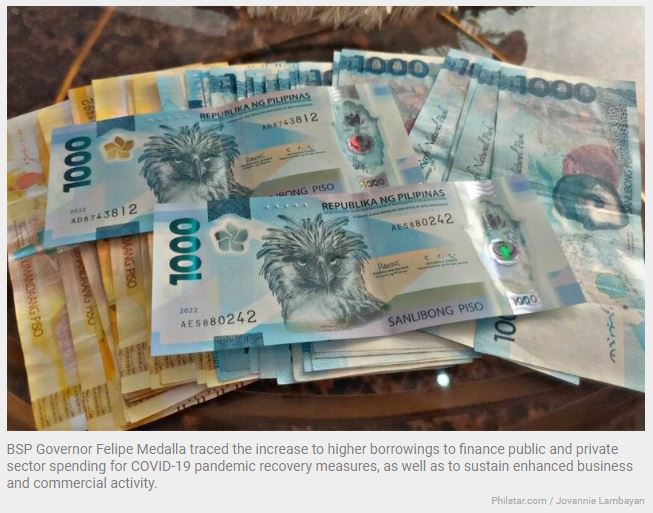Philippines external debt hits record high $111.3 billion in 2022
MANILA, Philippines — The country’s external debt rose by 4.5 percent to hit a record high of $111.27 billion last year from $106.43 billion in 2021, as both the national government and the private sector borrowed more from offshore creditors, according to the Bangko Sentral ng Pilipinas.
BSP Governor Felipe Medalla traced the increase to higher borrowings to finance public and private sector spending for COVID-19 pandemic recovery measures, as well as to sustain enhanced business and commercial activity.
The Philippines maintained its strong rebound from the pandemic-induced recession as gross domestic product (GDP) accelerated by 7.6 percent last year, slightly exceeding the government’s 6.5 to 7.5 percent target. The economy grew by only 5.7 percent in 2021.
Medalla said the country’s external debt-to-GDP ratio increased to 27.5 percent last year from 27 percent in 2021.
“The external debt-to-GDP ratio of 27.5 percent signals manageable debt levels, as well as the sustained capability of the country to service foreign borrowings in the medium- and long-term,” he said.
The BSP chief attributed the $4.84-billion increase in the country’s debt stock to net availments of $8.4 billion, largely by the national government, and prior periods’ adjustments of $1.6 billion.
The increase, Medalla explained, was tempered by the negative foreign exchange revaluation of $2.6 billion and the increase in residents’ investments in Philippine debt papers issued offshore of $2.6 billion.
The stronger dollar against major currencies, including the peso, helps temper the increase in foreign borrowings. The peso weakened by 9.3 percent to 55.755 last year from 50.999 to $1 in 2021.
Due to the aggressive rate hikes delivered by the BSP to tame inflation, as well as the central bank’s active intervention in the foreign exchange market, the peso bounced back toward the end of 2022 after slumping by as much as 15.7 percent to hit an all-time low of 59 to $1 in October last year.
The country’s external debt in end-December was 3.1-percent higher than the end-September level of $107.9 billion due to the net availments of $1.8 billion, with the national government’s issuance of $2 billion global bonds and the private sector banks’ external financing of $765 million to support relending activities and to service maturing obligations.
The appreciation of other currencies against the greenback in the fourth quarter increased the dollar equivalent of borrowings denominated in other currencies, resulting in an overall positive foreign exchange revaluation of $1.5 billion and prior periods’ adjustments of $59 million.
Medalla also reported an improvement in the country’s debt service ratio to 6.3 percent in 2022 from 7.5 percent in 2021 due to higher receipts and lower repayments.
He said the maturity profile of the country’s external debt remained predominantly medium- and long-term in nature, with original maturities longer than one year with share to total at 85.1 percent, while short-term accounts with maturities of up to one year comprised the 14.9 percent balance.
According to Medalla, public sector external debt declined by $928 million to $64.8 billion in end-September from $65.7 billion in end-June, accounting for 60 percent of the country’s foreign debt.
The public sector accounted for 60.6 percent or $67.4 billion of the country’s total external debt, with the national government cornering 88.7 percent or $59.8 billion.
On the other hand, the private sector accounted for the remaining 39.4 percent or $43.9 billion of the total external debt.
Major creditor countries include Japan ($14.7 billion) followed by the US ($3.5 billion) and the United Kingdom ($3.2 billion).
Borrowings from multilateral lending institutions and bilateral creditors have the largest share of 37.9 percent, followed by loans in the form of bonds or notes with a 33.1-percent share, and obligations to foreign banks and other financial institutions with 22.9 percent.
The remaining 6.1 percent came from other creditors such as suppliers and exporters.
In terms of currency mix, the country’s debt stock remained largely denominated in dollar (77.9 percent) and Japanese yen ( 8.8 percent).
The national government borrows heavily from foreign and domestic creditors to finance the country’s budget deficit as it spends more than what it actually earns.
Source: https://www.philstar.com/business/2023/03/20/2252881/philippines-external-debt-hits-record-high-1113-billion-2022


 Thailand
Thailand




